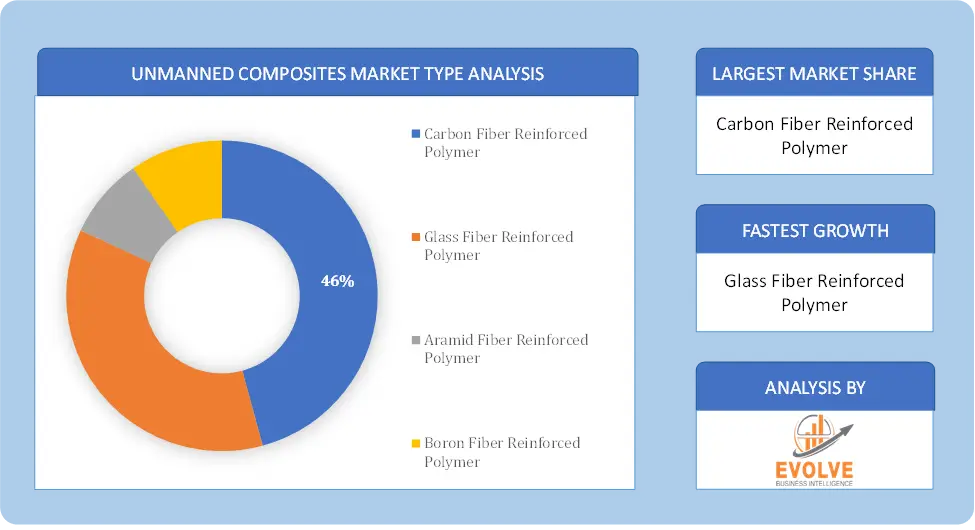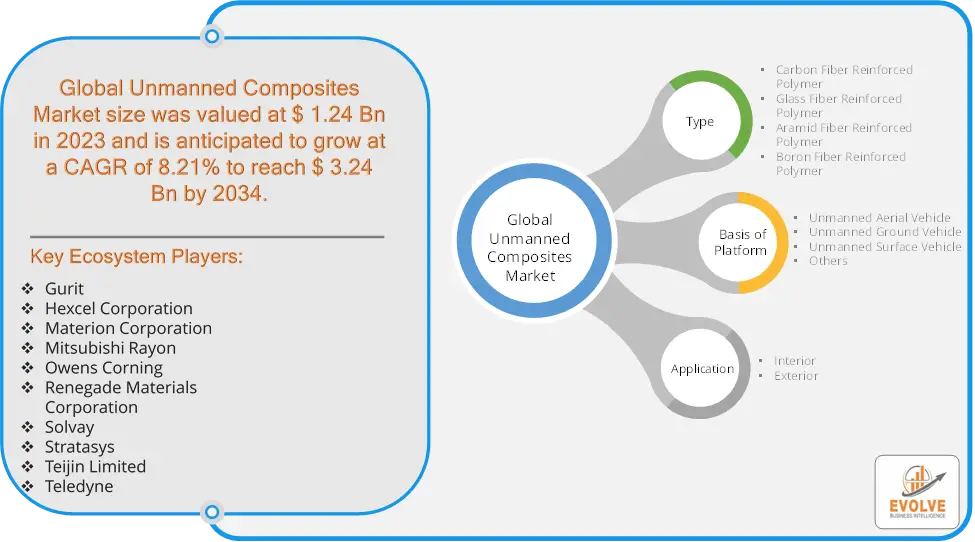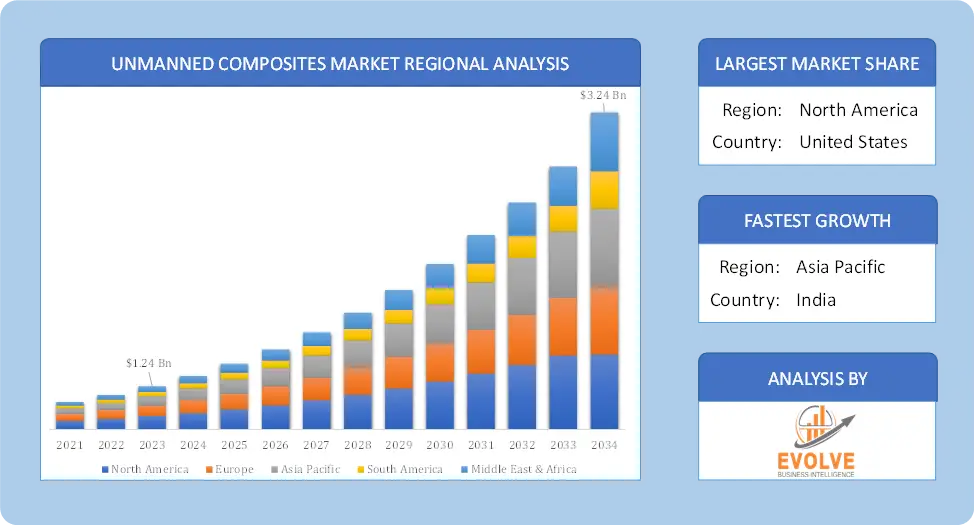Unmanned Composites Market Analysis and Global Forecast 2021-2034
$ 1,390.00 – $ 5,520.00Price range: $ 1,390.00 through $ 5,520.00
Unmanned Composites Market Research Report: Information By Type (Carbon Fiber Reinforced Polymer, Glass Fiber Reinforced Polymer, Aramid Fiber Reinforced Polymer, Boron Fiber Reinforced Polymer), By Application (Interior, Exterior), By Basis of platform (Unmanned Aerial Vehicle, Unmanned Ground Vehicle, Unmanned Surface Vehicle, Others), and by Region — Forecast till 2033
Page: 122
Unmanned Composites Market Overview
The Unmanned Composites Market Size is expected to reach USD 3.24 Billion by 2033. The Unmanned Composites Market industry size accounted for USD 1.24 Billion in 2023 and is expected to expand at a compound annual growth rate (CAGR) of 8.21% from 2023 to 2033. The Unmanned Composites Market refers to the market for composite materials used in the construction and manufacturing of unmanned systems, such as drones, unmanned aerial vehicles (UAVs), unmanned ground vehicles (UGVs), and unmanned underwater vehicles (UUVs). Composites, which are materials made from two or more constituent elements with different physical or chemical properties, are increasingly used in unmanned systems due to their high strength-to-weight ratio, durability, and resistance to corrosion.
The unmanned composites market is a rapidly growing sector that plays a crucial role in enabling the development and deployment of advanced unmanned systems.
Global Unmanned Composites Market Synopsis
 Unmanned Composites Market Dynamics
Unmanned Composites Market Dynamics
The major factors that have impacted the growth of Unmanned Composites Market are as follows:
Drivers:
Ø Advancements in Composite Manufacturing Technologies
3D printing and advanced fabrication techniques are improving the production of complex composite componnets allowing for faster, more cost-effective, and customizable solutions in unmanned systems. Automation in composite manufacturing processes is reducing labor costs and enhancing production precision, fueling growth in the unmanned composites market. Unmanned vehicles are becoming increasingly important in sectors such as energy, construction, logistics, and agriculture. These industries require durable and lightweight materials for their unmanned vehicles, contributing to the demand for composites.
Restraint:
- Perception of High Manufacturing Costs and Time-Consuming Production
Advanced composites like carbon fiber-reinforced polymers (CFRP) are costly to produce, making the initial investment for manufacturing unmanned vehicles higher. This can limit their adoption, especially for cost-sensitive sectors or applications. The manufacturing of composite component often requires skilled labor and complex processes such as hand lay-up or autoclave curing, which can increase production costs. The fabrication of composite materials is often more time-consuming than traditional materials like metals, due to intricate layering and curing processes. This can slow down production timelines, limiting the ability to scale.
Opportunity:
⮚ Expansion of Unmanned Systems in Space Exploration
The growing use of unmanned systems in space exploration, including satellites and robotic spacecraft, presents a unique opportunity for the use of high-performance composites. These materials are critical for reducing weight and increasing fuel efficiency in space missions. Unmanned systems used in military and aerospace operations often operate in challenging conditions, creating demand for materials with high strength and resistance to wear and tear.
Unmanned Composites Market Segment Overview
By Basis of Platform
Based on Basis of Platform, the market has been divided into Unmanned Aerial Vehicle, Unmanned Ground Vehicle, Unmanned Surface Vehicle and Others. The Unmanned Aerial Vehicle (UAV) segment dominant the market. The popularity of UAVs can be attributed to their wide range of applications, from surveillance and reconnaissance to parcel delivery and agricultural monitoring. Their versatility and the ongoing advancements in drone technology have made them a key driver in the unmanned composites market.
By Type
 Based on Type, the market has been divided into Carbon Fiber Reinforced Polymer, Glass Fiber Reinforced Polymer, Aramid Fiber Reinforced Polymer and Boron Fiber Reinforced Polymer. The carbon fiber reinforced polymer (CFRP composites) segment dominant the market. The demand for lightweight and cost-effective unmanned system component is increasing from (Ems) all over the world. Carbon fiber is a combination of carbon atoms that are aligned parallel to the main axis of the filament, providing durability to the structure and ease of use in all commercial applications. These factors influence the CFRP segment’s growth.
Based on Type, the market has been divided into Carbon Fiber Reinforced Polymer, Glass Fiber Reinforced Polymer, Aramid Fiber Reinforced Polymer and Boron Fiber Reinforced Polymer. The carbon fiber reinforced polymer (CFRP composites) segment dominant the market. The demand for lightweight and cost-effective unmanned system component is increasing from (Ems) all over the world. Carbon fiber is a combination of carbon atoms that are aligned parallel to the main axis of the filament, providing durability to the structure and ease of use in all commercial applications. These factors influence the CFRP segment’s growth.
By Applications
Based on Application, the market is segmented based on Interior and Exterior. The Interior segment dominated the market. Furthermore, benefits such as high strength and efficiency offered by unmanned composites are expected to increase demand for unmanned composites for manufacturing interior component and vehicles.
Global Unmanned Composites Market Regional Analysis
Based on region, the global Unmanned Composites Market has been divided into North America, Europe, Asia-Pacific, the Middle East & Africa, and Latin America. North America is projected to dominate the use of the Unmanned Composites Market followed by the Asia-Pacific and Europe regions.
 Global Unmanned Composites North America Market
Global Unmanned Composites North America Market
North America holds a dominant position in the Unmanned Composites Market. North America, particularly the United States, is one of the largest markets for unmanned composites due to substantial investments in the aerospace, defense, and commercial sectors and the U.S. has a robust defense industry with extensive use of unmanned aerial vehicles (UAVs) for military purposes, including surveillance, reconnaissance, and combat missions. The U.S. Department of Defense (DoD) is a major buyer of unmanned systems, driving the demand for advanced composite materials.
Global Unmanned Composites Asia-Pacific Market
The Asia-Pacific region has indeed emerged as the fastest-growing market for the Unmanned Composites Market industry. The Asia-Pacific region is experiencing significant growth in the unmanned composites market, driven by rising defense budgets and increasing demand for UAVs in both military and commercial sectors. China is a major manufacturer of UAVs and is investing heavily in advanced materials like composites to improve performance. India, with its expanding defense sector and rising commercial drone market, is also a key market for unmanned composites.
Competitive Landscape
The global Unmanned Composites Market is highly competitive, with numerous players offering a wide range of software solutions. The competitive landscape is characterized by the presence of established companies, as well as emerging startups and niche players. To
Prominent Players:
- Gurit
- Hexcel Corporation
- Materion Corporation
- Mitsubishi Rayon
- Owens Corning
- Renegade Materials Corporation
- Solvay
- Stratasys
- Teijin Limited
- Teledyne
Key Development
In August 2023– Toray is committed to achieving sustainable growth as one of the fundamental strategies of its medium-term management program, “Project AP-G 2025,” The aerospace applications of its carbon fiber composite materials business are positioned as products that accelerate climate change countermeasures by this strategy.
In August 2023– Stratasys launched its entry-level J3TM DentaJet 3D printer earlier this year, complementing its more advanced J5TM DentaJet model.
Scope of the Report
Global Unmanned Composites Market, by Application
- Interior
- Exterior
Global Unmanned Composites Market, by Basis of Platform
- Unmanned Aerial Vehicle
- Unmanned Ground Vehicle
- Unmanned Surface Vehicle
- Others
Global Unmanned Composites Market, by Type
- Carbon Fiber Reinforced Polymer
- Glass Fiber Reinforced Polymer
- Aramid Fiber Reinforced Polymer
- Boron Fiber Reinforced Polymer.
Global Unmanned Composites Market, by Region
- North America
- US
- Canada
- Mexico
- Europe
- UK
- Germany
- France
- Italy
- Spain
- Benelux
- Nordic
- Rest of Europe
- Asia Pacific
- China
- Japan
- South Korea
- Indonesia
- Austalia
- Malaysia
- India
- Rest of Asia Pacific
- South America
- Brazil
- Argentina
- Rest of South America
- Middle East & Africa
- Saudi Arabia
- UAE
- Egypt
- South Africa
- Rest of Middle East & Africa
| Parameters | Indicators |
|---|---|
| Market Size | 2033: $3.24 Billion |
| CAGR | 8.21% CAGR (2023-2033) |
| Base year | 2022 |
| Forecast Period | 2023-2033 |
| Historical Data | 2021 |
| Report Coverage | Revenue Forecast, Competitive Landscape, Growth Factors, and Trends |
| Key Segmentations | Application, Basis of Platform, Type |
| Geographies Covered | North America, Europe, Asia-Pacific, Latin America, Middle East, Africa |
| Key Vendors | Gurit, Hexcel Corporation, Materion Corporation, Mitsubishi Rayon, Owens Corning, Renegade Materials Corporation, Solvay, Stratasys, Teijin Limited and Teledyne |
| Key Market Opportunities | • Expansion of Unmanned Systems in Space Exploration |
| Key Market Drivers | • Advancements in Composite Manufacturing Technologies |
REPORT CONTENT BRIEF:
- High-level analysis of the current and future Unmanned Composites Market trends and opportunities
- Detailed analysis of current market drivers, restraining factors, and opportunities in the future
- Unmanned Composites Market historical market size for the year 2021, and forecast from 2023 to 2033
- Unmanned Composites Market share analysis at each product level
- Competitor analysis with detailed insight into its product segment, Government & Defense strength, and strategies adopted.
- Identifies key strategies adopted including product launches and developments, mergers and acquisitions, joint ventures, collaborations, and partnerships as well as funding taken and investment done, among others.
- To identify and understand the various factors involved in the global Unmanned Composites Market affected by the pandemic
- To provide a detailed insight into the major companies operating in the market. The profiling will include the Government & Defense health of the company’s past 2-3 years with segmental and regional revenue breakup, product offering, recent developments, SWOT analysis, and key strategies.
Press Release

Global Pharmaceutical Manufacturing Market to Reach $1.38 Trillion by 2035 with 7.35% CAGR, New Research Shows

The Global Mammography Market Is Estimated To Record a CAGR of Around 10.29% During The Forecast Period

Glue Stick Market to Reach USD 2.35 Billion by 2034

Podiatry Service Market to Reach USD 11.88 Billion by 2034

Microfluidics Technology Market to Reach USD 32.58 Billion by 2034

Ferric Chloride Market to Reach USD 10.65 Billion by 2034

Family Practice EMR Software Market to Reach USD 21.52 Billion by 2034

Electric Hairbrush Market to Reach USD 15.95 Billion by 2034

Daily Bamboo Products Market to Reach USD 143.52 Billion by 2034

Cross-border E-commerce Logistics Market to Reach USD 112.65 Billion by 2034
Frequently Asked Questions (FAQ)
What is the study period of this market?
The study period of the global Unmanned Composites Market is 2021- 2033
What is the growth rate of the global Unmanned Composites Market?
The global Unmanned Composites Market is growing at a CAGR of 4.58% over the next 10 years
Which region has the highest growth rate in the market of Unmanned Composites Market?
Asia Pacific is expected to register the highest CAGR during 2023-2033
Which region has the largest share of the global Unmanned Composites Market?
North America holds the largest share in 2022
Who are the key players in the global Unmanned Composites Market?
Gurit, Hexcel Corporation, Materion Corporation, Mitsubishi Rayon, Owens Corning, Renegade Materials Corporation, Solvay, Stratasys, Teijin Limited and Teledyne. are the major companies operating in the market
Do you offer Post Sale Support?
Yes, we offer 16 hours of analyst support to solve the queries
Do you sell particular sections of a report?
Yes, we provide regional as well as country-level reports. Other than this we also provide a sectional report. Please get in contact with our sales representatives
Table of Content
Chapter 1. Executive Summary Chapter 2. Scope Of The Study 2.1. Market Definition 2.2. Scope Of The Study 2.2.1. Objectives of Report Chapter 3. Evolve BI Methodology Chapter 4. Market Insights and Trends 4.1. Supply/ Value Chain Analysis 4.2. Porter’s Five Forces Analysis 4.2.1. Threat Of New Entrants 4.2.2. Bargaining Power Of Buyers 4.2.3. Bargaining Power Of Suppliers 4.2.4. Threat Of Substitutes 4.2.5. Industry Rivalry 4.3. Impact of COVID-19 on Unmanned Composites Market 4.3.1. Impact on Market Size 4.3.2. End User Trend, Preferences and Budget Impact 4.3.3. Regulatory Framework/Government Policies 4.3.4. Key Players Strategy to Tackle Negative Impact 4.3.5. Opportunity Window Chapter 5. Market Dynamics 5.1. Introduction 5.2. DRO Analysis 5.2.1. Drivers 5.2.2. Restraints 5.2.3. Opportunities Chapter 6. Global Unmanned Composites Market, By application 6.1. Introduction 6.2. Interior 6.3. Exterior Chapter 7. Global Unmanned Composites Market, By basis of platform 7.1. Introduction 7.2. Unmanned Aerial Vehicle 7.3. Unmanned Ground Vehicle 7.4. Unmanned Surface Vehicle 7.5. Others Chapter 8. Global Unmanned Composites Market, By Type 8.1. Introduction 8.2. Carbon Fiber Reinforced Polymer 8.3. Glass Fiber Reinforced Polymer 8.4. Aramid Fiber Reinforced Polymer 8.5. Boron Fiber Reinforced Polymer Chapter 9. Global Unmanned Composites Market, By Region 9.1. Introduction 9.2. North America 9.2.1. Introduction 9.2.2. Driving Factors, Opportunity Analyzed and Key Trends 9.2.3. Market Size and Forecast, By Country, 2020 - 2028 9.2.4. Market Size and Forecast, By application, 2020 - 2028 9.2.5. Market Size and Forecast, By basis of platform, 2020 – 2028 9.2.6. Market Size and Forecast, By Type, 2020 – 2028 9.2.7. US 9.2.7.1. Introduction 9.2.7.2. Driving Factors, Opportunity Analyzed and Key Trends 9.2.7.3. Market Size and Forecast, By application, 2020 - 2028 9.2.7.4. Market Size and Forecast, By basis of platform, 2020 – 2028 9.2.7.5. Market Size and Forecast, By Type, 2020 - 2028 9.2.8. Canada 9.2.8.1. Introduction 9.2.8.2. Driving Factors, Opportunity Analyzed and Key Trends 9.2.8.4. Market Size and Forecast, By application, 2020 - 2028 9.2.8.5. Market Size and Forecast, By basis of platform, 2020 – 2028 9.2.8.6. Market Size and Forecast, By Type, 2020 - 2028 9.3. Europe 9.3.1. Introduction 9.3.2. Driving Factors, Opportunity Analyzed and Key Trends 9.3.3. Market Size and Forecast, By Country, 2020 - 2028 9.3.4. Market Size and Forecast, By application, 2020 - 2028 9.3.5. Market Size and Forecast, By basis of platform, 2020 – 2028 9.3.6. Market Size and Forecast, By Type, 2020 – 2028 9.3.7. Germany 9.3.7.1. Introduction 9.3.7.2. Driving Factors, Opportunity Analyzed and Key Trends 9.3.7.3. Market Size and Forecast, By application, 2020 - 2028 9.3.7.4. Market Size and Forecast, By basis of platform, 2020 – 2028 9.3.7.5. Market Size and Forecast, By Type, 2020 - 2028 9.3.8. France 9.3.8.1. Introduction 9.3.8.2. Driving Factors, Opportunity Analyzed and Key Trends 9.3.8.3. Market Size and Forecast, By application, 2020 - 2028 9.3.8.4. Market Size and Forecast, By basis of platform, 2020 – 2028 9.3.8.5. Market Size and Forecast, By Type, 2020 - 2028 9.3.9. UK 9.3.9.1. Introduction 9.3.9.2. Driving Factors, Opportunity Analyzed and Key Trends 9.3.9.3. Market Size and Forecast, By application, 2020 - 2028 9.3.9.4. Market Size and Forecast, By basis of platform, 2020 – 2028 9.3.9.5. Market Size and Forecast, By Type, 2020 - 2028 9.3.10. Italy 9.3.10.1. Introduction 9.3.10.2. Driving Factors, Opportunity Analyzed and Key Trends 9.3.10.3. Market Size and Forecast, By application, 2020 - 2028 9.3.10.4. Market Size and Forecast, By basis of platform, 2020 – 2028 9.3.10.5. Market Size and Forecast, By Type, 2020 - 2028 9.3.11. Rest Of Europe 9.3.11.1. Introduction 9.3.11.2. Driving Factors, Opportunity Analyzed and Key Trends 9.3.11.3. Market Size and Forecast, By application, 2020 - 2028 9.3.11.4. Market Size and Forecast, By basis of platform, 2020 – 2028 9.3.11.5. Market Size and Forecast, By Type, 2020 - 2028 9.4. Asia-Pacific 9.4.1. Introduction 9.4.2. Driving Factors, Opportunity Analyzed and Key Trends 9.4.3. Market Size and Forecast, By Country, 2020 - 2028 9.4.4. Market Size and Forecast, By application, 2020 - 2028 9.4.5. Market Size and Forecast, By basis of platform, 2020 – 2028 9.4.7. Market Size and Forecast, By Type, 2020 - 2028 9.4.8. China 9.4.8.1. Introduction 9.4.8.2. Driving Factors, Opportunity Analyzed and Key Trends 9.4.8.3. Market Size and Forecast, By application, 2020 - 2028 9.4.8.4. Market Size and Forecast, By basis of platform, 2020 – 2028 9.4.8.5. Market Size and Forecast, By Type, 2020 - 2028 9.4.9. India 9.4.9.1. Introduction 9.4.9.2. Driving Factors, Opportunity Analyzed and Key Trends 9.4.9.3. Market Size and Forecast, By application, 2020 - 2028 9.4.9.4. Market Size and Forecast, By basis of platform, 2020 – 2028 9.4.9.5. Market Size and Forecast, By Type, 2020 - 2028 9.4.10. Japan 9.4.10.1. Introduction 9.4.10.2. Driving Factors, Opportunity Analyzed and Key Trends 9.4.10.3. Market Size and Forecast, By application, 2020 - 2028 9.4.10.4. Market Size and Forecast, By basis of platform, 2020 – 2028 9.4.10.5. Market Size and Forecast, By Type, 2020 - 2028 9.4.11. South Korea 9.4.11.1. Introduction 9.4.11.2. Driving Factors, Opportunity Analyzed and Key Trends 9.4.11.3. Market Size and Forecast, By application, 2020 - 2028 9.4.11.4. Market Size and Forecast, By basis of platform, 2020 – 2028 9.4.11.5. Market Size and Forecast, By Type, 2020 - 2028 9.4.12. Rest Of Asia-Pacific 9.4.11.1. Introduction 9.4.12.2. Driving Factors, Opportunity Analyzed and Key Trends 9.4.12.3. Market Size and Forecast, By application, 2020 - 2028 9.4.12.4. Market Size and Forecast, By basis of platform, 2020 – 2028 9.4.12.5. Market Size and Forecast, By Type, 2020 - 2028 9.5. Rest Of The World (RoW) 9.5.1. Introduction 9.5.2. Driving Factors, Opportunity Analyzed and Key Trends 9.5.3. Market Size and Forecast, By application, 2020 - 2028 9.5.4. Market Size and Forecast, By basis of platform, 2020 – 2028 9.5.5. Market Size and Forecast, By Type, 2020 - 2028 9.5.6. Market Size and Forecast, By Region, 2020 - 2028 9.5.7. South America 9.5.7.1. Introduction 9.5.7.2. Driving Factors, Opportunity Analyzed and Key Trends 9.5.7.3. Market Size and Forecast, By application, 2020 - 2028 9.5.7.4. Market Size and Forecast, By basis of platform, 2020 – 2028 9.5.7.5. Market Size and Forecast, By Type, 2020 - 2028 9.5.8. Middle East & Africa 9.5.8.1. Introduction 9.5.8.2. Driving Factors, Opportunity Analyzed and Key Trends 9.5.8.3. Market Size and Forecast, By application, 2020 - 2028 9.5.8.4. Market Size and Forecast, By basis of platform, 2020 – 2028 9.5.8.5. Market Size and Forecast, By Type, 2020 - 2028 Chapter 10. Competitive Landscape 10.1. Introduction 10.2. Vendor Share Analysis, 2020/Key Players Positioning 2020 Chapter 11. Company Profiles 11.1. Gurit 11.1.1. Business Overview 11.1.2. Financial Analysis 11.1.3. Product Portfolio 11.1.4. Recent Development and Strategies Adopted 11.1.5. SWOT Analysis 11.2. Hexcel Corporation 11.2.1. Business Overview 11.2.2. Financial Analysis 11.2.3. Product Portfolio 11.2.4. Recent Development and Strategies Adopted 11.2.5. SWOT Analysis 11.3. Materion Corporation 11.3.1. Business Overview 11.3.2. Financial Analysis 11.3.3. Product Portfolio 11.3.4. Recent Development and Strategies Adopted 11.3.5. SWOT Analysis 11.4. Mitsubishi Rayon 11.4.1. Business Overview 11.4.2. Financial Analysis 11.4.3. Product Portfolio 11.4.4. Recent Development and Strategies Adopted 11.4.5. SWOT Analysis 11.5. Owens Corning 11.5.1. Business Overview 11.5.2. Financial Analysis 11.5.3. Product Portfolio 11.5.4. Recent Development and Strategies Adopted 11.5.5. SWOT Analysis 11.6. Renegade Materials Corporation 11.6.1. Business Overview 11.6.2. Financial Analysis 11.6.3. Product Portfolio 11.6.4. Recent Development and Strategies Adopted 11.6.5. SWOT Analysis 11.7. Solvay 11.7.1. Business Overview 11.7.2. Financial Analysis 11.7.3. Product Portfolio 11.7.4. Recent Development and Strategies Adopted 11.7.5. SWOT Analysis 11.8. Stratasys 11.8.1. Business Overview 11.8.2. Financial Analysis 11.8.3. Product Portfolio 11.8.4. Recent Development and Strategies Adopted 11.8.5. SWOT Analysis 11.9. Teijin Limited 11.9.1. Business Overview 11.9.2. Financial Analysis 11.9.3. Product Portfolio 11.9.4. Recent Development and Strategies Adopted 11.9.5. SWOT Analysis 11.10. Teledyne 11.10.1. Business Overview 11.10.2. Financial Analysis 11.10.3. Product Portfolio 11.9.4. Recent Development and Strategies Adopted 11.9.5. SWOT Analysis Chapter 12. Key Takeaways
Connect to Analyst
Research Methodology








